Catskills 2
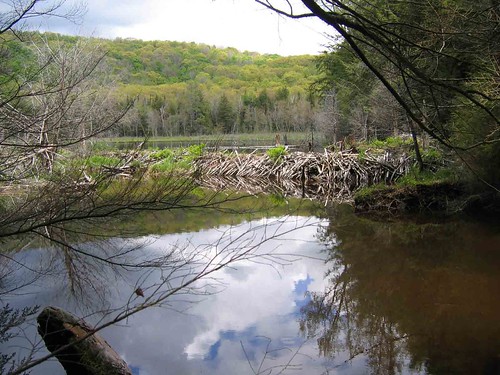
The most massive beaver dam ever! Beavers are...(wait for it)...extirpated (gone, dead, locally extinct) in NYC.
Today we walked out to a bog that had been "lost" for over 100 years. Since this site has a number of rare species, I will limit site location to "Ulster County".
The walk out there was enchanting - an abundance of Eastern hemlocks (Tsuga canadensis), young and old co-mingling - these were, amazingly, free of the hemlock woolly adelgid, (Adelges tsugae), the trees in our neck of the woods are usually older (i.e, no regeneration) and dying (i.e., infested with aphids). The hemlocks cast a deep, dark shade. A thick layer of sphagnum moss carpeted the forest floor, punctuated by drifts of ferns and common wood sorrel (Oxalis montana). I half expected to see leprachauns darting between tree trunks. This wood sorrel is not the same plant as the ubiquitous sidewalk weed we have here. If only O. montana were common in the five boroughs, but that's what you get for being sans mountains.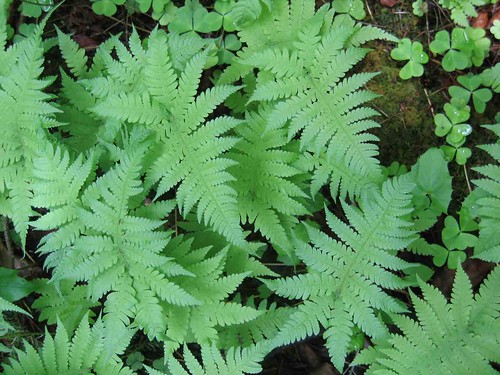
Long beechfern (Phegopteris connectilis), with wood sorrel & sphagnum moss peaking out from underneath. More plants native to New York State that are absent in the five boroughs. sniff.
The bog itself was amazing, with more heath shrubs than you could shake a stick at. There were blueberries and cranberries (Vaccinium spp.) and laurels (Rhododendron spp.) and winterberries (Ilex verticillata). I was in heaven. I love the heaths! (Maybe because it reminds me of the romantic moors in Scotland...)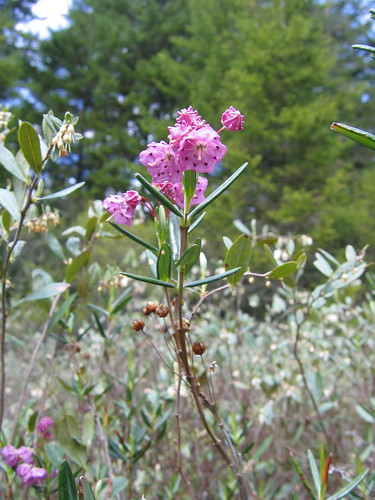
Another native heath shrub, bog laurel (Kalmia polifolia). I wish this were in the city.
Another highlight was tussock cottongrass (Eriophorum vaginatum var. spissum). This bog is the plant's only appearance in Ulster County.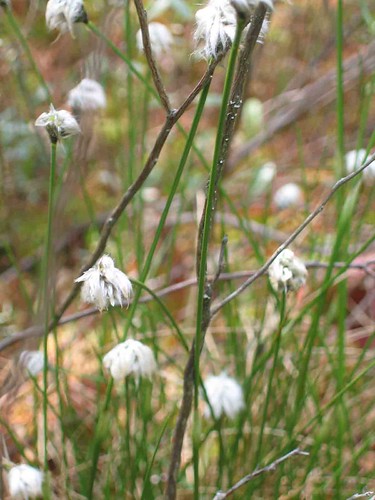
Despite it's common name, tussock cottongrass (Eriophorum vaginatum var. spissum) is actually a sedge. Ah, botanical linguistics.
One of the saddest sights was the discovery of plastic pots strewn around the bog. This was an indication that people steal plants from this place to sell on the cheap. This is especially true for plants that are popular/unusual and slow growing, such as trilliums, orchids, heath shrubs, pitcher plants, and sundews. Once these plants are taken from there ecological context, their chances of survival are slim. Your backyard in Brooklyn sure as hell ain't a bog. Plant poaching is far too prevalent. Be mindful of plants offered for cheap, potted in soils that look "natural" (as opposed to a greenhouse mixture).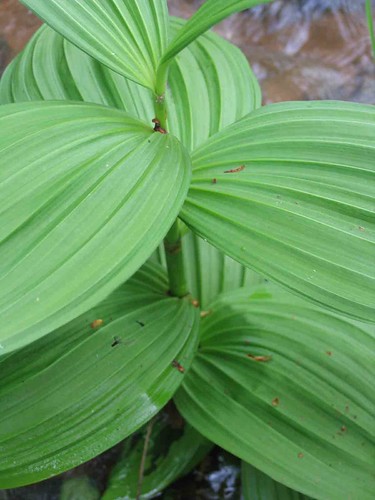
False hellebore (Veratrum viride). This beautiful native forb is extirpated (locally extinct) in NYC. That's a sad thing.
The day ended with a scramble to see the Adoxa before sundown. This tiny plant is typical of circumboreal regions. This population is a disjunct, with other populations found in the western U.S. Muskroot (Adoxa moschatellina) is rare in NY. We found the strikingly drab forb along a shale road cut. It was neat to see the muskroot, but what really caught my eye was the purple clematis (Clematis occidentalis var. occidentalis). Look below, can you blame me?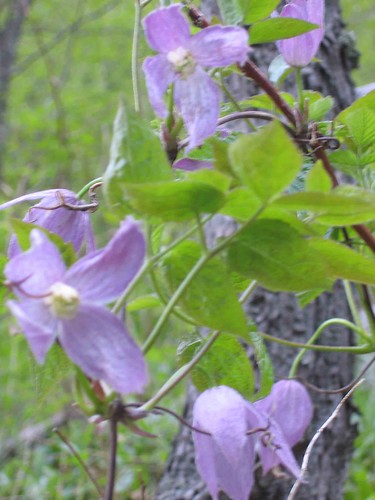
Purple clematis (Clematis occidentalis var. occidentalis)
Plant List - These are just the species I jotted down...
5/29
WALK TO BOG
TREES
Yellow birch (Betula alleghaniensis)
Red spruce (Picea rubens)
Eastern hemlock (Tsuga canadensis)
SHRUBS
Creeping snowberry (Gaultheria hispidula)
Eastern teaberry (G. procumbens)
Bog laurel (Kalmia polifolia)
Large cranberry (Vaccinium macrocarpon)
Small cranberry (Vaccinium oxycoccos)
FORBS
Threeleaf goldthread (Coptis trifolia)
Early coralroot (Corallorhiza trifida)
Bunchberry (Cornus canadensis)
Common wood sorrel (Oxalis montana)
Northern pitcher-plant (Sarracenia purpurea)
Heartleaf foamflower (Tiarella cordifolia var. cordifolia)
Purple trillium (Trillium erectum)
False hellebore (Veratrum viride)
GRAMINOIDS
Tussock cottongrass (Eriophorum vaginatum var. spissum)
FERNS
Long beechfern (Phegopteris connectilis)
Eastern marsh fern (Thelypteris palustris)
Sphagnum sp.
MESIC FOREST
FORBS
Red baneberry (Actaea rubra)
Jack-in-the-pulpit (Arisaema triphyllum)
Ramps (Allium tricoccum)
Crinkleroot (Cardamine diphylla)
Blue cohosh (Caulophyllum thalictroides)
Horsebalm (Collinsonia canadensis)
Squirrelcorn (Dicentra canadensis)
Trout lily (Erythronium americanum)
Fragrant bedstraw (Galium triflorum)
Virginia waterleaf (Hydrophyllum virginianum)
Twisted-stalk (Streptopus roseus)
Foamflower (Tiarella cordifolia)
Purple trillium (Trillium erectum)
Painted trillium (T. undulatum)
False hellebore (Veratrum viride)
Canada violet (Viola canadensis)
Marsh violet (V. cucullata)
Yellow forest violet (V. pubescens)
White violet (V. renifolia)
Roundleaf yellow violet (V. rotundifolia)
Common blue violet (V. sororia)
FERNS
Ostrich fern (Matteuccia struthiopteris)
Christmas fern (Polystichum acrostichoides)
SHALE SLOPES
SHRUBS
American black currant (Ribes americanum)
Red elderberry (Sambucus racemosa var. racemosa)
FORBS
Red baneberry (Actaea rubra)
Muskroot (Adoxa moschatellina)
Pussytoes (Antennaria canadensis)
Wild columbine (Aquilegia canadensis)
Early saxifrage (Saxifraga virginiensis var. virginiensis)
FERNS
Western oakfern (Gymnocarpium dryopteris)
VINES
Purple clematis (Clematis occidentalis var. occidentalis)





2 comments:
I Live in Ulster County, I love that bog.
Unbelievable that in this day and age when commercially sold material is so available that people are still stealing from the wild. Not the US but for example:
http://www.rhs.org.uk/rhsplantfinder/plantfinder.asp
Post a Comment